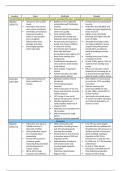Overig
GDR Full Notes
- Vak
- Instelling
An organised and detailed table of notes on the GDR - perfect for your Pearson Edexcel A-Level History exams! Includes aims, methods and results across the terms of both Ulbricht and Honecker for: social policies and welfare; economy; political control/Stasi; relations with USSR and its leaders; i...
[Meer zien]




